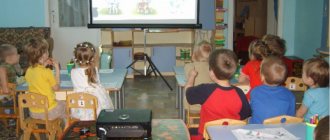Getting to know nature. Preparatory group (forward planning)
Liliya Pavlovna Shvendykh
Getting to know nature. Preparatory group (forward planning)
Literature: Solomennikova O. A. “
Introduction to nature in kindergarten ” Preparatory group for school .
2022 month theme, tasks page
SEPTEMBER
1. "Gifts of Autumn"
Page 33
Expand children's understanding of the diversity of plants,
their fruits. Learn to recognize plants by their fruits and name them correctly. Expand ideas about the diverse human uses of various fruits. Introduce the benefits of fruits for human health. To consolidate knowledge about methods of collecting, storing and preparing vegetables, fruits, berries and mushrooms. To form an aesthetic attitude towards the natural .
2. "Soil and underground inhabitants"
Page 34
Expand children's understanding of different types of soil. Bring to the understanding that there is air in the soil. Systematize knowledge about the adaptation of animals to life in the soil. Teach children to independently draw basic conclusions about environmental protection.
OCTOBER
1. “October 4 – World Animal Day”
Page 37
Expand children's understanding of the diversity of animals on different continents of the Earth. To develop an interest in the surrounding nature . Show the relationship between flora and fauna. Teach children to independently draw basic conclusions and conclusions about the life of animals and environmental protection.
2. “A golden leaf is already covering the wet ground in the forest...”
Page 38
Expand children's understanding of autumn changes in nature in September , October and November. Learn to notice the signs of autumn. Foster a caring attitude towards the natural environment . To form a desire to reflect the image of autumn in different time periods in creative works. Develop creative imagination.
NOVEMBER
1. "Birds of our region"
Page 40
Expand children's knowledge about the diversity of the animal world. Learn to recognize and correctly name birds living in your area. Improve the ability to identify the characteristic features of different birds. To develop an interest in the animal world, a desire to watch birds and help them in the winter. Learn how to create a passport for birds.
2. "Observation of a living object"
Page 43
Expand your understanding of ornamental animals. Learn to watch them without disturbing them. To lead to the ability to independently draw elementary conclusions and conclusions about the habits of animals. Create a desire to help care for them.
DECEMBER
1. "Plants and Animals in Winter"
Page 45
Enrich children's understanding of seasonal changes in nature . Continue to introduce the peculiarities of animal adaptation to their habitat in winter. Learn to establish connections between plants and animals in winter. Lead to an understanding of how a person can help animals survive the cold winter.
2. "Animals of reservoirs, seas and oceans"
Page 48
Expand children's understanding of the diversity of animals living in reservoirs, seas and oceans. Develop an interest in the natural and animals. To form ideas about the relationships between animals and their environment.
JANUARY
1. “Day of Nature Reserves (January 10)
» Page 50
Expand children's understanding of the diversity of the natural world . Give concepts about rare and endangered plants and animals listed in the Red Book. Form ideas about protected areas of your native land. Encourage children to be able to independently draw basic conclusions about environmental protection.
2. “Passing the ecological trail”
Page 53
Teach children to see changes in nature in winter . Expand vocabulary (snowfall, blizzard, blizzard, hoarfrost, ice crust, frost)
.
To form a desire to reflect the beauty of the surrounding nature in productive activities.
FEBRUARY
1. "Service Dogs"
Page 55
Expand children's knowledge about pets. Give an idea about service dogs. Show how dogs can help humans. To develop knowledge that a person should be able to care for animals that he has tamed . Instill interest and love for animals. Give basic ideas about the profession of a dog handler.
2. "Vegetable garden on the window"
Page 57
To form children's ideas about the diversity of cultivated plants and methods of planting them. Introduce methods of vegetative propagation of plants. Learn to plant seedlings (onions, maybe radishes)
. In the process of practical activities, learn to draw basic conclusions about the relationship of plants and how to care for them.
MARCH
1. "Admire
: spring is coming..." Pg. 58
Expand children's ideas about spring changes in nature , teach them to notice them. Give the concept that air temperature is determined using a thermometer. Systematize knowledge about animal life in the spring. Learn to determine the weather using folk signs.
2. “March 22 – World Water Day”
Page 61
Expand children's understanding of the importance of water in nature . Form ideas about the transition of a solid into a liquid and vice versa. In the process of experimental activities, learn to independently obtain basic knowledge about nature . Develop an interest in the natural .
APRIL
1. " Nature "
Page 63
Expand children's understanding of the diversity of flora and fauna. Learn to quickly find the answer to a question. Develop cognitive activity and creative initiative.
2. “April 22 – International Earth Day”
Page 65
Expand children's understanding that the Earth is our common home. To clarify knowledge about the natural and climatic zones of our country - deserts, forests, steppes, mountains. Bring to the understanding that human life depends on the environment - the purity of air, soil and water. Learn to establish cause and effect relationships between natural phenomena .
MAY
1. “Passing the ecological trail”
Page 66
Expand children's understanding of seasonal changes in nature while walking an ecological trail in the kindergarten area. To form a desire to conduct observations in nature . Develop curiosity and activity. Support independent search and research activities. Foster a caring attitude towards nature . To form an aesthetic attitude towards nature .
2. "Flower Carpet"
Page 69
Expand children's understanding of the diversity of flowering plants and their significance in nature . Foster a caring attitude towards nature . Learn to see and convey the beauty of flowering plants in productive activities. Develop cognitive interest . To form an aesthetic attitude towards nature .





